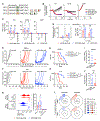Targeting GPC2 on Intraocular and CNS Metastatic Retinoblastomas with Local and Systemic Delivery of CAR T Cells
- PMID: 38864848
- PMCID: PMC11326963
- DOI: 10.1158/1078-0432.CCR-24-0221
Targeting GPC2 on Intraocular and CNS Metastatic Retinoblastomas with Local and Systemic Delivery of CAR T Cells
Abstract
Purpose: Retinoblastoma is the most common intraocular malignancy in children. Although new chemotherapeutic approaches have improved ocular salvage rates, novel therapies are required for patients with refractory intraocular and metastatic disease. Chimeric antigen receptor (CAR) T cells targeting glypican-2 (GPC2) are a potential new therapeutic strategy.
Experimental design: GPC2 expression and its regulation by the E2F1 transcription factor were studied in retinoblastoma patient samples and cellular models. In vitro, we performed functional studies comparing GPC2 CAR T cells with different costimulatory domains (4-1BB and CD28). In vivo, the efficacy of local and systemic administration of GPC2 CAR T cells was evaluated in intraocular and leptomeningeal human retinoblastoma xenograft models.
Results: Retinoblastoma tumors, but not healthy retinal tissues, expressed cell surface GPC2, and this tumor-specific expression was driven by E2F1. GPC2-directed CARs with 4-1BB costimulation (GPC2.BBz) were superior to CARs with CD28 stimulatory domains (GPC2.28z), efficiently inducing retinoblastoma cell cytotoxicity and enhancing T-cell proliferation and polyfunctionality. In vivo, GPC2.BBz CARs had enhanced persistence, which led to significant tumor regression compared with either control CD19 or GPC2.28z CARs. In intraocular models, GPC2.BBz CAR T cells efficiently trafficked to tumor-bearing eyes after intravitreal or systemic infusions, significantly prolonging ocular survival. In central nervous system (CNS) retinoblastoma models, intraventricular or systemically administered GPC2.BBz CAR T cells were activated in retinoblastoma-involved CNS tissues, resulting in robust tumor regression with substantially extended overall mouse survival.
Conclusions: GPC2-directed CAR T cells are effective against intraocular and CNS metastatic retinoblastomas.
©2024 American Association for Cancer Research.
Conflict of interest statement
K.R.B., J.B.F. and G.P.-P have applied for patents for the discovery and development of immunotherapies for cancer, including patents related to GPC2-directed immunotherapies. K.R.B receives royalties from Tmunity/Kite Pharma and ConjugateBio, Inc. for licensing of GPC2-related technology and funding from Tmunity/Kite Pharma and ConjugateBio, Inc. for research on GPC2-directed immunotherapies. K.R.B. is on the ConjugateBio Scientific Advisory Board. J.B.F. receives royalties from Tmunity/Kite Pharma for licensing of GPC2-related technology. The other authors declare no potential conflicts of interest.
Figures





References
MeSH terms
Substances
Grants and funding
LinkOut - more resources
Full Text Sources
Research Materials

